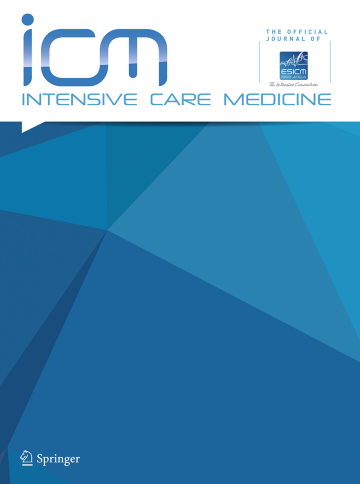从表面到核心:更好的冷却对心脏骤停有影响吗?
IF 27.1
1区 医学
Q1 CRITICAL CARE MEDICINE
引用次数: 0
摘要
缺氧缺血性脑损伤(HIBI)是院外心脏骤停(OHCA) bbb后入院重症监护病房(ICU)患者死亡的主要原因。初步试验显示,在停搏后将温度控制在32-36°C 12-24小时可能有益,因此,控制性低温已被广泛用于减轻HIBI。然而,在2021年,TTM-2随机临床试验(RCT)将1900名ohca后HIBI的成年人分配到33°C的控制低温或控制常温,早期治疗发热(体温≥37.8°C) 24小时,然后在前72小时避免双臂发热,6个月时的死亡率没有差异。心律失常导致血流动力学损伤在低温组更为常见。这些结果促使欧洲复苏委员会(ERC)和欧洲重症监护医学学会(ESICM)推荐HIBI成年患者在头72小时内积极预防发热,而不是降低体温。本文章由计算机程序翻译,如有差异,请以英文原文为准。

From surface to core: does better cooling make a difference after cardiac arrest?
Hypoxic-ischaemic brain injury (HIBI) is the primary cause of death in patients who are admitted to the intensive care unit (ICU) after out-of-hospital cardiac arrest (OHCA) [1]. Controlled hypothermia has been widely used to mitigate HIBI, following initial trials showing potential benefit from temperature control at 32–36 °C for 12–24 h after arrest [2]. However, in 2021, the TTM-2 randomised clinical trial (RCT)—that assigned 1900 adults with post-OHCA HIBI to controlled hypothermia at 33 °C or controlled normothermia with early treatment of fever (body temperature ≥ 37.8 °C) for 24 h followed by avoidance of fever in both arms for the first 72 h—showed no difference in mortality at 6 months [3]. Arrhythmia resulting in haemodynamic compromise was more common in the hypothermia arm. These results led the European Resuscitation Council (ERC) and the European Society of Intensive Care Medicine (ESICM) to recommend actively preventing fever for HIBI instead of hypothermia for the first 72 h in adult patients with HIBI [4].
求助全文
通过发布文献求助,成功后即可免费获取论文全文。
去求助
来源期刊

Intensive Care Medicine
医学-危重病医学
CiteScore
51.50
自引率
2.80%
发文量
326
审稿时长
1 months
期刊介绍:
Intensive Care Medicine is the premier publication platform fostering the communication and exchange of cutting-edge research and ideas within the field of intensive care medicine on a comprehensive scale. Catering to professionals involved in intensive medical care, including intensivists, medical specialists, nurses, and other healthcare professionals, ICM stands as the official journal of The European Society of Intensive Care Medicine. ICM is dedicated to advancing the understanding and practice of intensive care medicine among professionals in Europe and beyond. The journal provides a robust platform for disseminating current research findings and innovative ideas in intensive care medicine. Content published in Intensive Care Medicine encompasses a wide range, including review articles, original research papers, letters, reviews, debates, and more.
 求助内容:
求助内容: 应助结果提醒方式:
应助结果提醒方式:


